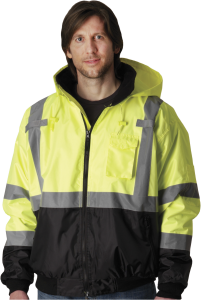12 Nov Winter Checklist

We’re beginning to see leaves falling and feeling the chill wind of winter blowing in. For industries that have outside personnel, gearing up for cold weather is an essential task that many of us have already begun to do.
Outfitting the Team with Suitable Gear
Many industries provide their staff with the outerwear they use on the job. Many see it as an opportunity to promote brand awareness to have all the public-facing employees dressed in matching uniforms with the company logo prominently displayed. The color scheme is often limited to hi-vis and black per ANSI requirements, but there are many distinctive styles now available in a variety of weights for any climate.
Every year brings with it the latest innovation in high-tech cold weather materials, and the more advanced the technology, the higher the price tag. But staying warm and productive does not require an investment in the latest technologies unless you want to.
I call to mind the first successful mission to the South Pole. Two teams set off in 1911 in separate campaigns to be the first. The successful team, led by Norwegian Roald Amundsen, kept warm using the time-tested animal pelts and clothing worn by indigenous inhabitants of arctic climate zones. The other team, led by British team leader Robert Falcon Scott, wore the most updated cold weather gear available from the finest outfitter on the continent. All five of Amundsen’s party lived to celebrate their achievement, while none of Scott’s team came back alive.
We must be careful not to draw faulty conclusions from this story. There is no indication that the state-of-the-art arctic apparel chosen by Scott contributed to the failure of the expedition. The point I am making by telling the story is that the successful party survived by doing a lot of things right even though the cold weather gear they used was not state-of-the-art.
Whether new school or old school, keeping warm in cold weather requires the following basic elements:
- Insulation. This will usually consist of some structural matrix that traps air, which is a really effective insulator.
- Transpiration. Active workers can work up a sweat even in cold environments, and the moisture needs to escape somehow before it saturates inner layers, is allowed to get cold and convect body heat away from the core.
- Water repellent outer layer. The ideal outer shell for keeping warm won’t allow wind, melting snow or slush penetrate, but will allow perspiration to exit.
There are many ANSI rated garments available to industry that do an excellent job of providing these elements.
The ANSI Rating System
Sometimes the shorthand we use in the safety business gets tossed around as if everyone knows about the underlying compliance issues. We commonly use the terms Class 2 and Class 3, and most of us know that road workers and waste haulers need to wear Class 3 even if they don’t quite understand why. These are department of transportation requirements that prescribe the placement of reflective striping and hi-vis fabric for traffic not exceeding 25 MPH for Class 2 and anything over that speed for Class 3. After the latest revision to ANSI/ISEA 107, you may have noticed hi-vis rated garments not only advertise a Class 2 or Class 3 rating, but “Type R” is often added to the designation. There is also Type O and Type P, but these types of hi-vis categories apply to more specialized purposes. Type O is only designated for off road use, and Type P designates standards appropriate to public safety workers such as police officers.
Many jackets come with zip-out liners, which is a feature to consider since it gives the garment more versatility in a wider range of temperatures. The zip-out liner is a layer that can be removed if the weather warms up as the day progresses. The only drawback is keeping track of the removable pieces of the garment in the midst of the bustle of getting work done.
Extremely cold temperatures call for more specialized gear such as snowmobile-suit style coveralls and mittens in place of gloves. The more contiguous the outfit, the less opportunities there are for the warm air inside your garment to escape.
There are a wide variety of thermal lined work gloves available nowadays, with styles available in whatever cut level or puncture level your team is required to wear. Additionally, chemically reactive pillows such as Hot Rods can be placed inside work gloves to provide a source of heat for 8 hours once they are activated.
Two-piece outer garments such as Class E thermal pants or bib overalls combined with a jacket are also effective in northern climates. The “Class E” designation means the bottom half of the outfit can be combined with a Class 2 top half to make the whole ensemble Class 3. The Class E designation is only assigned to pants or bib overalls, and a Class E garment on its own does not satisfy any ANSI hi-vis requirements.
Keeping feet warm is best accomplished by keeping them dry. Waterproof over-boots can make all the difference in protecting feet from frostbite and discomfort. It’s important to allow enough space inside boots for good foot circulation.
Elastic ice traction attachments are easily stretched over toes and heels of footwear to give them added bite when road slush turns to ice.
Preparing for winter is not limited to clothing. Vehicles also need to be winterized, which, in northern climates might require a number of steps beyond the scope of this article. Ice melt granules, snow scrapers, and de-icing aerosols, and even jump boxes are all proactive steps you can take to ensure smooth starts on those frosty mornings.
For all climates, the steps you take to prepare for winter can make a difference in the comfort and productivity of your team.



No Comments